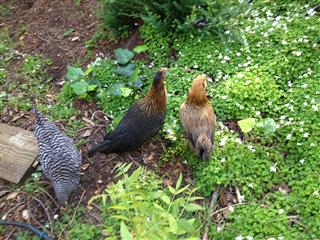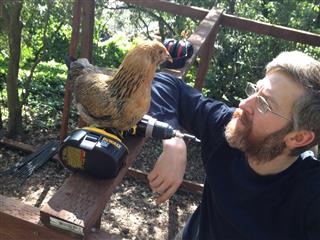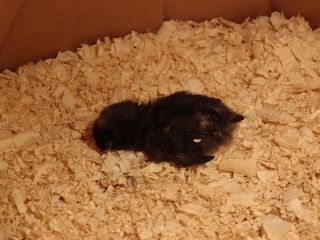Las Pollas Hermanas
 On December 28, 2014, three little fluffballs came into our life. They arrived in a beer box in an extended-cab F150 from a farm in Lompoc that does a weekly round of deliveries to Bay Area hipsters. The young crew quickly set up the chick-brooder shuttlecraft and heat lamp, selected our three babies from the carton of befuddled peeps, and voila: instant chicken farm! For the first seven weeks, our girls lived in their brooder in our spare bedroom, producing an exponentially astonishing volume of droppings and becoming more and more restless. Finally, when they were fully feathered, they moved out to their custom-built house.
On December 28, 2014, three little fluffballs came into our life. They arrived in a beer box in an extended-cab F150 from a farm in Lompoc that does a weekly round of deliveries to Bay Area hipsters. The young crew quickly set up the chick-brooder shuttlecraft and heat lamp, selected our three babies from the carton of befuddled peeps, and voila: instant chicken farm! For the first seven weeks, our girls lived in their brooder in our spare bedroom, producing an exponentially astonishing volume of droppings and becoming more and more restless. Finally, when they were fully feathered, they moved out to their custom-built house.
Interview with the Chicklets:
Q: Are you organic?
A: No, we're not. Our primary ration is Organic Layer Pellets from Modesto Milling, but we share almost anything that our people eat, and their diet is not always organic.
Q: What's your favorite food?
A: We love bread, watermelon, oatmeal, sweet potatoes, pasta salad, corn, quinoa, and mealworms. Every night, the snack fairy hangs a vegetable (broccoli, bell peppers, zucchini, or corn on the cob) in our run so we can play tetherball when we wake up. We don't love carrots, celery, or turnips.
Q: Are you free-range?
A: Nope. Although we'd probably enjoy it, we face too many predatory threats: there are hawks in the trees in our neighborhood, Naya-kitty from the neighbors' house chases us, and the neighbors have lost a chicken to raccoons. At night and during the human workday, we live in our chicken fortress (complete with subterranean concrete barrier to keep out burrowing aggressors). When our people are home, we have the run of the backyard, where we eat grass, oxalis, and all sorts of bugs.
Q: What's your lifespan? Do you fear being slaughtered when you stop laying?
A: We don't want to be a pie: we don't like gravy! When our egg production drops after about 2 years, we will continue to be part of the family. More chickens may be added to the flock, but everyone is promised to live out her natural lifespan (probably 8 years or so, barring predation), aided by whatever veterinary care is legal (it's complicated because although we are pets, we are food animals in the eyes of the law).
Aether
Breed: Likely Black sex-link
First egg: May 11, 2015
Egg color: pink-beige with tiny white freckles
Aether is the alpha chicken. Mostly, this means that she is the first to eat when special treats arrive. However, with great gluttony comes great responsibility, and she does play the role of defender when the flock is out foraging. Even as a hatchling, she would vigorously peck any human who harassed her sisters, and she still gives us a good stare-down from time to time.
Perigee
 Hatchday: Dec 14, 2014
Hatchday: Dec 14, 2014Breed: Easter-Egger
First egg: May 12, 2015
Egg color: pale green
Easter eggers are not a true breed; rather, it's a term applied to mixed-breed chickens who lay green or blue eggs. Because they're not an actual breed, their phenotypes vary widely. Our little Perigee appears to be more falcon than chicken. She's the flightiest of the bunch, both in her skittishness and her propensity to take wing. The first time she was attacked by Naya, the neighbor's cat, Perigee flew a good 10 meters up into the live oak above the henhouse. Fortunately, she's our smartest chicken, and she found her own way down without mishap. She also prefers flying to trotting when trying to catch up with the others.
Mantissa
 Hatchday: Dec 21, 2014
Hatchday: Dec 21, 2014Died: December 3, 2017
Breed: Barred Plymouth Rock
First egg: June 12, 2015
Egg color: toasted almond
Mantissa was our special child. On December 2, 2017, she didn't come out for treats as usual. I found her in the corner of the run, looking quite woozy. She regurgitated greenish fluid from her crop when I picked her up. After several frantic phone calls, I found a chicken vet who would see her on a Saturday. The doctor identified dehydration, emaciation, and crop stasis, which is nonspecific. He lavaged her crop, gave her subcutaneous fluids, and collected a crop swab for culture. He sent us home with instructions to tube feed Carnivore Care liquid diet (made of chicken...eewww), TMS (antibiotic) and fluconazole (antifungal). I set her up in the bathroom with her chickhood heat lamp. Every time I handled her for her treatments, she'd go limp and unresponsive for a couple of minutes. The last time I saw her alive was for her midnight treatment on the 2nd. The next morning she was dead, planted face down in her shavings, exactly as she used to sprawl as a baby. I kept her refrigerated until Monday, then packed her up with ice packs and sent her to UC Davis for a necropsy. That came back inconclusive as well, except that we now know she didn't have avian flu (yay).
Previous bio: She's extremely sweet but doesn't have a lot going on in her head. She's a bit like Dory from Finding Nemo. She also has bilaterally symmetrical deformed digits. We wondered about correcting them when she was little, but after consulting with our vet friend and chicken mentor, Paula, we decided it wasn't worth the stress of splinting and isolating her, so she just walks around on her little curly toes. Consequently, she's a little more awkward than her sisters, but she does not seem at all painful, and she digs and roosts just as well as the others. Her main handicap seems to be cheerful obliviousness: during the attack that prompted Perigee to fly into a tree and Aether to take cover under a bush, Mantissa continued foraging. "Just keep digging, digging, digging..."